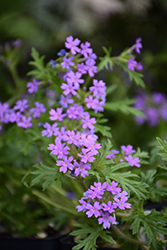It's all about ...
plants

Davis Mountain Mock Vervain
Glandularia wrightii
Plant Height: 6 inches
Flower Height: 12 inches
Spacing: 14 inches
Sunlight:
![]()
![]()
Hardiness Zone: 6a
Other Names: Wright's Vervain, Verbena wrightii, Desert Verbena
Description:
This beautiful plant can be found in meadows, and Ponderosa Pine forests; tolerates semi-desert conditions; great to naturalize in grassland, or rocky, sandy areas; perfect for dry border fronts or rock gardens
Ornamental Features
Davis Mountain Mock Vervain features showy clusters of hot pink trumpet-shaped flowers with violet overtones at the ends of the stems from mid spring to late summer, which emerge from distinctive fuchsia flower buds. Its small deeply cut ferny leaves remain forest green in colour throughout the season.
Landscape Attributes
Davis Mountain Mock Vervain is a dense herbaceous perennial with a mounded form. It brings an extremely fine and delicate texture to the garden composition and should be used to full effect.
This plant will require occasional maintenance and upkeep, and should be cut back in late fall in preparation for winter. It is a good choice for attracting butterflies to your yard. Gardeners should be aware of the following characteristic(s) that may warrant special consideration;
- Spreading
Davis Mountain Mock Vervain is recommended for the following landscape applications;
- Mass Planting
- Rock/Alpine Gardens
- Border Edging
- General Garden Use
- Groundcover
- Naturalizing And Woodland Gardens
Planting & Growing
Davis Mountain Mock Vervain will grow to be only 6 inches tall at maturity extending to 12 inches tall with the flowers, with a spread of 18 inches. When grown in masses or used as a bedding plant, individual plants should be spaced approximately 14 inches apart. Its foliage tends to remain low and dense right to the ground. It grows at a fast rate, and under ideal conditions can be expected to live for approximately 5 years. As an herbaceous perennial, this plant will usually die back to the crown each winter, and will regrow from the base each spring. Be careful not to disturb the crown in late winter when it may not be readily seen!
This plant does best in full sun to partial shade. It is very adaptable to both dry and moist growing conditions, but will not tolerate any standing water. It is considered to be drought-tolerant, and thus makes an ideal choice for a low-water garden or xeriscape application. This plant does not require much in the way of fertilizing once established. It is not particular as to soil pH, but grows best in sandy soils. It is somewhat tolerant of urban pollution, and will benefit from being planted in a relatively sheltered location. This species is native to parts of North America. It can be propagated by division.
This plant is not reliably hardy in our region, and certain restrictions may apply; contact the store for more information.
